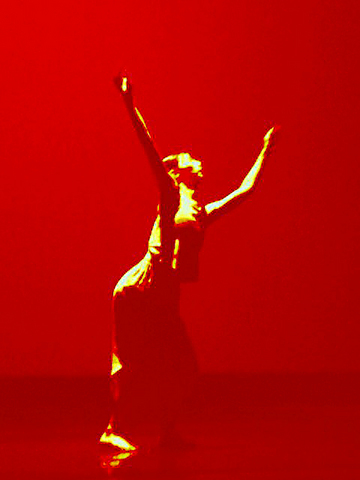Modern dance pieces often take their cues from rave culture these days.
"I've made enquiries from ravers on numerous occasions and been amazed by the way they dance, with their body movements so free of restraint and with a touch of primitivism. I draw my inspiration from them and created this piece titled Crossing Fire (過火), a term taken from the Taiwanese ancient ritual of crossing fire that symbolizes purification," said director and choreographer You Shao-jing (游紹菁).
One of the best professional dancers in Taiwan, You is also the choreographer of White Dance Temple (白舞寺), which was founded in Ilan County, 2001. It fuses traditional art forms such as puppet theater and Taiwanese opera.

PHOTO COURTESY OF WHAT DANCE TEMPLEN
Crossing Fire is the company's first attempt to return to a more pure and absolute form of dance.
In a telephone interview, You said he deconstructed the body language of ravers and added layers of movement until there was a climax at the end.
"Crossing Fire is the most physically demanding and satisfying dancing experience a performer could ever have. The level of energy needed is unbelievable high," You said. "We have to let go of our mind and let our bodies take total control to probe deeply into a state of trance. It's a direct sensory experience. The audience won't understand the piece if they try to think," You said.
In an intimate setting the dancers bizarrely blend into projections of fast-moving Taiwanese urban landscapes in an attempt to convey the historical and cultural condition of modern life.
Crossing Fire is not meant to be about personal expression, You said, but intends to attain a collective state of oneness, as achieved in ancient rituals held during temple celebrations.
Crossing Fire will start on Aug. 10 in Ilan County, then tour in Taichung and conclude with two shows in Taipei. Tickets are NT$100 for shows in Ilan and Taichung; NT$300 for shows in Taipei, available at the door, or call (02) 2272 6899.

On April 26, The Lancet published a letter from two doctors at Taichung-based China Medical University Hospital (CMUH) warning that “Taiwan’s Health Care System is on the Brink of Collapse.” The authors said that “Years of policy inaction and mismanagement of resources have led to the National Health Insurance system operating under unsustainable conditions.” The pushback was immediate. Errors in the paper were quickly identified and publicized, to discredit the authors (the hospital apologized). CNA reported that CMUH said the letter described Taiwan in 2021 as having 62 nurses per 10,000 people, when the correct number was 78 nurses per 10,000

As we live longer, our risk of cognitive impairment is increasing. How can we delay the onset of symptoms? Do we have to give up every indulgence or can small changes make a difference? We asked neurologists for tips on how to keep our brains healthy for life. TAKE CARE OF YOUR HEALTH “All of the sensible things that apply to bodily health apply to brain health,” says Suzanne O’Sullivan, a consultant in neurology at the National Hospital for Neurology and Neurosurgery in London, and the author of The Age of Diagnosis. “When you’re 20, you can get away with absolute

May 5 to May 11 What started out as friction between Taiwanese students at Taichung First High School and a Japanese head cook escalated dramatically over the first two weeks of May 1927. It began on April 30 when the cook’s wife knew that lotus starch used in that night’s dinner had rat feces in it, but failed to inform staff until the meal was already prepared. The students believed that her silence was intentional, and filed a complaint. The school’s Japanese administrators sided with the cook’s family, dismissing the students as troublemakers and clamping down on their freedoms — with

As Donald Trump’s executive order in March led to the shuttering of Voice of America (VOA) — the global broadcaster whose roots date back to the fight against Nazi propaganda — he quickly attracted support from figures not used to aligning themselves with any US administration. Trump had ordered the US Agency for Global Media, the federal agency that funds VOA and other groups promoting independent journalism overseas, to be “eliminated to the maximum extent consistent with applicable law.” The decision suddenly halted programming in 49 languages to more than 425 million people. In Moscow, Margarita Simonyan, the hardline editor-in-chief of the